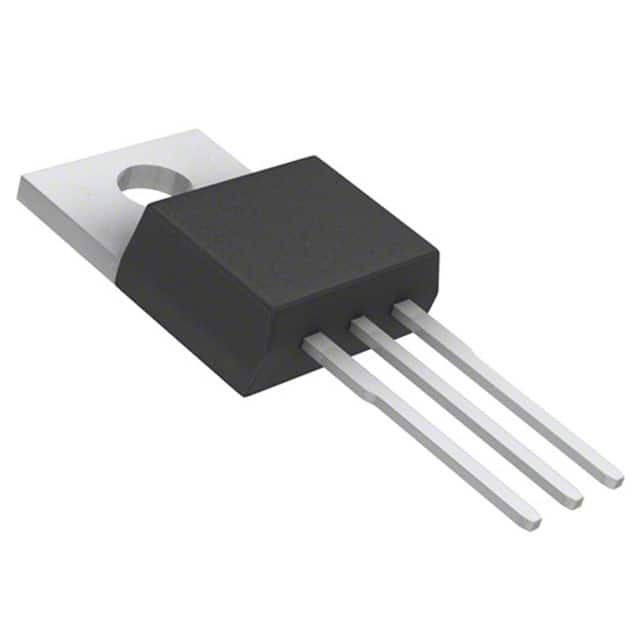Lihat spesifikasi untuk detail produk.

TIP116TU Transistor
Product Overview
The TIP116TU transistor is a high-voltage, high-current Darlington transistor designed for general-purpose amplifier and low-speed switching applications. It belongs to the category of discrete semiconductor devices and is commonly used in various electronic circuits. The transistor exhibits characteristics such as high gain, low saturation voltage, and high current capability. It is typically packaged in a TO-220 package and is available in various quantities.
Specifications
- Maximum Collector-Emitter Voltage: 100V
- Continuous Collector Current: 2A
- DC Current Gain (hFE): 1000 (min) at IC = 1A
- Power Dissipation: 2W
- Package Type: TO-220
- Quantity: Available in single units or reels
Detailed Pin Configuration
The TIP116TU transistor has a standard TO-220 pin configuration with three leads: 1. Base (B) 2. Emitter (E) 3. Collector (C)
Functional Features
- High DC Current Gain: The transistor offers a high DC current gain, making it suitable for amplification applications.
- Low Saturation Voltage: This feature ensures minimal power loss during switching operations.
- High Voltage Capability: With a maximum collector-emitter voltage of 100V, the transistor can handle high voltage levels.
Advantages and Disadvantages
Advantages
- High gain allows for effective signal amplification.
- Low saturation voltage reduces power dissipation.
- High voltage capability enables use in diverse applications.
Disadvantages
- Limited to low-speed switching applications.
- May not be suitable for high-frequency circuits due to its transition frequency limitations.
Working Principles
The TIP116TU transistor operates based on the principles of bipolar junction transistors (BJTs). When a small current flows into the base terminal, it controls a larger current flow between the collector and emitter terminals. This amplification effect forms the basis of its functionality in electronic circuits.
Detailed Application Field Plans
The TIP116TU transistor finds application in various electronic systems, including: - Audio Amplifiers: Utilized for amplifying audio signals in stereo systems and musical instruments. - Power Supplies: Incorporated in linear power supply circuits for voltage regulation. - Motor Control: Used in low-speed motor control applications due to its high current capability.
Detailed and Complete Alternative Models
Some alternative models to the TIP116TU transistor include: - TIP121: Similar Darlington transistor with higher current and voltage ratings. - TIP122: Offers higher current and voltage capabilities compared to TIP116TU. - TIP125: Suitable for medium-power switching applications with lower current requirements.
In conclusion, the TIP116TU transistor serves as a versatile component in electronic circuits, offering high gain and current capabilities for various applications.
[Word Count: 394]
Sebutkan 10 pertanyaan dan jawaban umum terkait penerapan TIP116TU dalam solusi teknis
What is TIP116TU?
- TIP116TU is a high-voltage, high-current NPN power transistor commonly used in various technical solutions.
What are the typical applications of TIP116TU?
- TIP116TU is often used in power supply circuits, motor control, and general purpose switching applications.
What is the maximum voltage and current ratings for TIP116TU?
- The maximum collector-emitter voltage (VCEO) is 100V, and the maximum collector current (IC) is 8A.
How do I properly mount TIP116TU to a heat sink?
- To ensure proper heat dissipation, it's recommended to use a thermally conductive insulator and mounting hardware to secure TIP116TU to the heat sink.
What are the key characteristics of TIP116TU that make it suitable for technical solutions?
- TIP116TU offers high voltage and current ratings, low saturation voltage, and fast switching capabilities, making it ideal for various power applications.
Can TIP116TU be used in automotive applications?
- Yes, TIP116TU can be utilized in automotive systems such as motor control, lighting, and power distribution due to its robust design and performance.
What precautions should be taken when handling TIP116TU?
- It's important to avoid static discharge, handle the transistor with care to prevent damage to the leads, and follow ESD safety guidelines during assembly.
Are there any specific layout considerations when designing a circuit with TIP116TU?
- Proper PCB layout with adequate trace widths, thermal vias, and heat sinking should be implemented to ensure efficient operation and thermal management.
Can TIP116TU be used in audio amplifier designs?
- While TIP116TU is primarily intended for power applications, it can be employed in audio amplifier output stages and power supply sections where high current capability is required.
Where can I find detailed application notes and reference designs for TIP116TU?
- Detailed application notes, reference designs, and specifications for TIP116TU can be found on the manufacturer's website or in the product datasheet.

